Did
a woman serve as the Roman Catholic pope in the ninth century?
In
a medieval mystery of the Catholic Church lies evidence of
a woman pope, with clues buried in ancient parchment, artwork
and writings, even in tarot cards and a bizarre chair once
used in a Vatican ritual.
Was there a Pope Joan -- a woman with nerve enough to disguise
herself as a man and serve as pope for more than two years
in the ninth century? It is one of the world's oldest mysteries.
Her story first appeared in histories written by medieval
monks, but today the Catholic Church dismisses it.
"Ninety percent of me thinks there was a Pope Joan,"
says Mary Malone, a former nun who wrote a history of women
and Christianity.
Donna Cross, a novelist who spent seven years researching
the time period, says the historical evidence is there. "I
would say it's the weight of evidence -- over 500 chronicle
accounts of her existence."
Life was often short and brutal for women living in A.D. 800.
"No woman would have been allowed to appear on the streets
in public," says Malone. "That named you as a prostitute
immediately. Women were confined to their homes."
In the town of Mainz, Germany, where it is thought the girl
who might have became Pope Joan grew up, most people lived
in mud huts. The average life span was only 30 or 40 years.
But English missionaries were bringing Christianity to Germany,
and they created a monastery called Fulda, which became a
center of education, books and conversation for travelers
-- but it was only for boys.
In his "History of Emperors and Popes," a monk named
Martin Polonus who was a close adviser to the pope wrote about
a young woman from Mainz who learned Greek and Latin and became
"proficient in a diversity of branches of knowledge."
Cross and other historians say a girl studying at the monastery
would have no choice but to disguise herself as a boy. But
how was it possible to keep the secret?
"First of all, you might want to remember that clerical
robes are very body-disguising," says Cross. "Also,
in the ninth century, personal hygiene was nonexistent. Nobody
bathed. They washed their hands, their face, their feet, but
they didn't bathe."
Also, clergy members were required to be clean shaven, and
malnutrition made most men and women physically gaunt.
Polonus wrote that this woman was "led to Athens dressed
in the clothes of a man by a certain lover of hers."
Then, according to the 500 accounts, the woman made her way
to Rome.
In the ninth century, Rome and the Vatican were nothing like
today's solemn and civilized center of culture and faith.
Then the center of the Christian faith was home to bawdy monks,
scheming cardinals, cross-dressing saints, intrigue, melodrama,
corruption and violence.
"Popes ... killed each other off, hammered each other
to death," says Mary Malone, the former nun. "There
were 12-year-old popes ... we have knowledge of a 5-year-old
archbishop. ... It was a very odd time in history."
That also means it would have been a time of opportunity for
someone with ambition and nerve. The chronicles say that's
how Joan, known as John Anglicus, or English John, became
secretary to a curia, a cardinal, and then, as Polonus writes,
"the choice of all for pope" in the year A.D. 855.
Clues
in Art
If
you travel to Italy and ask questions about Pope Joan, many
people will direct you toward the clues embedded in art, literature
and architecture.
The Renaissance poet Giovanni Boccaccio, best known for writing
"The Decameron," also wrote a book on "100
Famous Women." No. 51 is Pope Joan.
Rare book dealers in Rome pull ancient tarot cards from their
shelves. The card for hidden knowledge is "La Papessa"
-- the Female Pope.
Quotes
From Researchers
Travel north to Siena to the Duomo, where inside the cathedral
is a gallery of terra-cotta busts depicting 170 popes, in
no particular order. In the 17th century, Cardinal Baronuis,
the Vatican librarian, wrote that one of the faces was a female
-- Joan the Female Pope.
Baronius also wrote that the pope at the time decreed that
the statue be destroyed, but some say the local archbishop
didn't want a good statue go to waste.
"The statue was transformed," believes Cross. "I
mean, literally, it was scraped off, her name, and written
on top of Pope Zachary."
At the Basilica in St. Peter's Square are carvings by Bernini,
one of the most famous artists of the 17th century. Among
the carvings are eight images of a woman wearing a papal crown,
and the images seem to tell the story of a woman giving birth
and a baby being born.
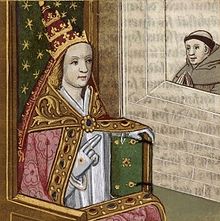
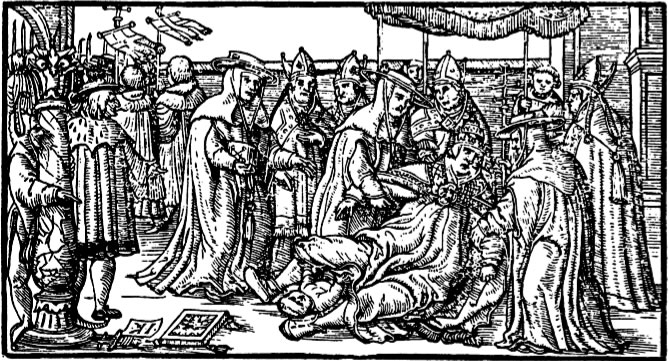
Medieval manuscripts tell a similar tale: Two-and-a-half years
into her reign, Pope Joan was in the midst of a papal procession,
a three-mile trip to the Church of the Lateran in Rome, when
suddenly at a crossroads, she felt sharp pains in her stomach.
She was having contractions, the stories say. The unthinkable
happened -- the pope was having a baby.
"And then, shock and horror," says Malone. "And
then the story gets very confused, because some of the records
say she was killed and her child was killed right on the spot.
Other records say she was sent to a convent and that her son
grew up and later became bishop of Ostia."
Stories vary -- some say the crowd stoned her to death, others
say she was dragged from the tail of a horse -- but in most
accounts, Pope Joan perished that day.
In the decades that followed, the intersection was called
the Vicus Papissa -- the Street of the Female Pope -- and
for more than 100 years, popes would take a detour to avoid
the shameful intersection.
Polonus writes: "The Lord Pope always turns aside from
the street ... because of the abhorrence of the event."
Just
an Urban Legend?
The
modern Catholic Church and many scholars dismiss the story
of Pope Joan as a sort of Dark Ages urban legend.
Valerie Hotchkiss, a professor of medieval studies at Southern
Methodist University in Texas, says that the story of Pope
Joan was actually added to Martin Polonus' manuscript after
he died.
"So he didn't write it, but it was put in very soon after
his death, like around 1280 to 1290," says Hotchkiss.
"And everyone picks it up from Martin Polonus."
Medieval monks were like copy machines, say some scholars,
simply replicating mistakes into the historical record.
"And they're picking it up from each other and changing
it and embellishing it," Hotchkiss says.
Monsignor Charles Burns, the former head of the Vatican secret
archives, says the story intrigued people in the Middle Ages
just as it intrigues people today. "This was almost like
an Agatha Christie," he says, referring to the classic
mystery writer.
Burns says there is no evidence and no documentation in the
secret archives that Pope Joan existed, no relic of Pope John
Anglicus anywhere.
And disbelievers can explain away the other clues. The Bernini
sculptures were modeled after the niece of the pope; the Vicus
Papissa was named for a woman who lived in the area.
Powerful and
Dangerous Women
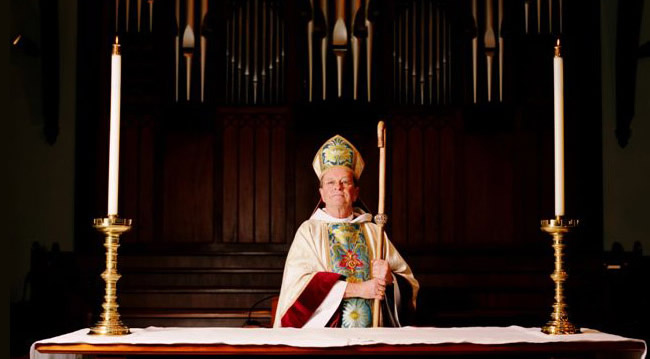
What do male Church leaders have against women?
Yet
even those who laugh at the story of the female pope agree
that the story opens a window on the history of women and
sex in the Catholic Church. Women were at one time a potent
and threatening force in the medieval Church.
Many scholars say there were many women martyrs in that era,
women who were tortured for their religious beliefs. And there
were women who became saints while cross-dressing as monks.
St. Eugenia, for example, became a monk while disguised as
a boy, and was so convincing she was brought to court on charges
of fathering a local woman's child. She finally proved her
innocence only by baring her breasts in public.
"There are over 30 saints' lives in which women dress
as men for a variety of reasons, and with a variety of outcomes,"
says Hotchkiss, who has written about these "transvestite
nuns."
Perhaps most threatening to the Church were two groups of
women known as beguines and mystics, who claimed they could
bypass the Church hierarchy and communicate directly with
God.
"And they really terrified the Church because they went
around saying things like 'My real name is God,'" says
Malone. "And so mysticism, then, gave these women ...
an access to God that was parallel to the Church."
These powerful women could have inspired a so-called crackdown
by the Church after A.D. 1000, consolidating its ranks and
reaffirming the rules on celibacy among its priests, a requirement
that's still controversial today.
One school of thought says the story of Pope Joan was invented
as a cautionary tale. The lesson to women: Don't even think
about reaching for power or you will end up like her -- exposed
and humiliated.
Another school argues that it was the fear of female power
that led the Church to essentially expunge Pope Joan from
history.
But how do historians explain the enormous purple marble chair
on which popes once sat as they were crowned. The chair has
a strange opening, something like a toilet seat, reportedly
used to check "testiculos habet" -- or whether the
pope had testicles.
David Dawson Vasquez, the director of Catholic University
of America's Rome program, says that the Vatican was just
using the most impressive chair it had.
"Because it's elaborate, it's purple. It was the most
expensive marble of Roman times, and so it was only used for
the emperor," Vasquez says. "The hole is there because
it was used by the imperial Romans, perhaps as a toilet, perhaps
as a birthing chair. It doesn't matter if there's a hole there,
because you can still sit there and be crowned."
Others say it was a symbol of the pope giving birth to the
Mother Church. Either way, newly minted Protestants in the
1500s had a field day making fun of the chair, and so it was
hidden from view.
And so the last relic in the tale of Pope Joan is withdrawn.
But Pope Joan lives on in some other place, in the shadows
of a Dark Ages legend that is terrifying to some and inspiring
to others. --

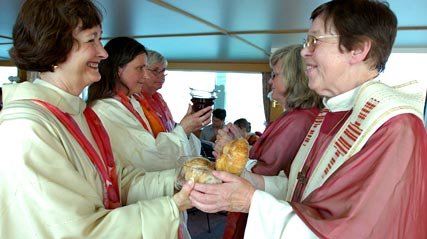
What
is it that the Church has against women?
Church sources told Catholic News Service that new
"norms," as the policies are called, will include
the "attempted ordination of women" among the list
of most serious crimes, or what are known as "delicta
graviora."
Sexual abuse of a minor by a priest was added to the classification
in 2001. The new norms are largely expected to codify changes
made in 2001 and 2003 that were aimed at addressing the burgeoning
clergy abuse scandal. But the policies expected to be issued
later this month will also specifically include the abuse
of mentally disabled adults as on par with abusing minors,
and it will extend the statute of limitations under the Church's
Code of Canon Law from 10 years after a victim turns 18 to
20 years.
Word that the Vatican will also use this opportunity to codify
the attempted ordination of a woman as a "delicta graviora"
is a surprise, however, and is not likely to please either
victims advocates -- who have been pushing for much more stringent
and universal church policies against abusers -- or those
who favor a greater role for women in the church.
"From
a woman all men are born.
How then can any man degrade any woman?"
"Quite
frankly, it is an outrage to pair the two, a complete injustice
to connect the aspirations of some women among the baptized
to ordained ministry with what are some of the worst crimes
that can be committed against the least of Christ's members,"
U.S. Catholic editor Bryan Cones wrote at the monthly magazine's
web site in a blast that appears to echo the views of many.
"This decision boggles the mind: The faithful have been
justly demanding for nearly a decade clear guidelines for
dealing with the sexual abuse of children, along with just
punishments for both offenders and bishops who have abetted
these crimes. What we have gotten is half of what we have
been asking for (still no sanctions for bishops), along with
a completely unconnected and unnecessary condemnation of the
ordination of women." --
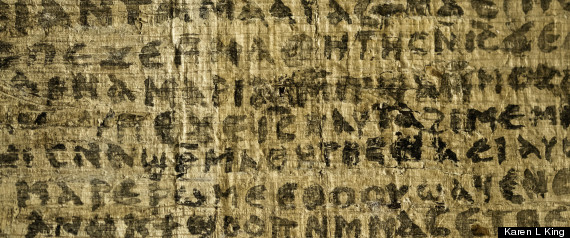
This papyrus fragment, found in 1997, indicates Jesus may have been married.

How Reincarnation Got Removed From Bible
Was
Jesus really born on December 25th?
What
Happens When You Meditate?
The Real Reason For The Season
Women's Health For Women Only
Tidbits
of Comparative Religion
All For One And 'Won' For All
Crucifixion By An Eyewitness
The After Death Experience
The Early Christian Writings
George Carlin On Religion
My Interview With God
Religions
of The World
The
Jesus Conspiracy
The
Gnostic Gospels
Pine
Tree Crosses
Disclaimer Caution
The Woman Pope
True
Perspective
Celebrate
Peace
Sacred
Places
What's Maya?
I Am IT
End
